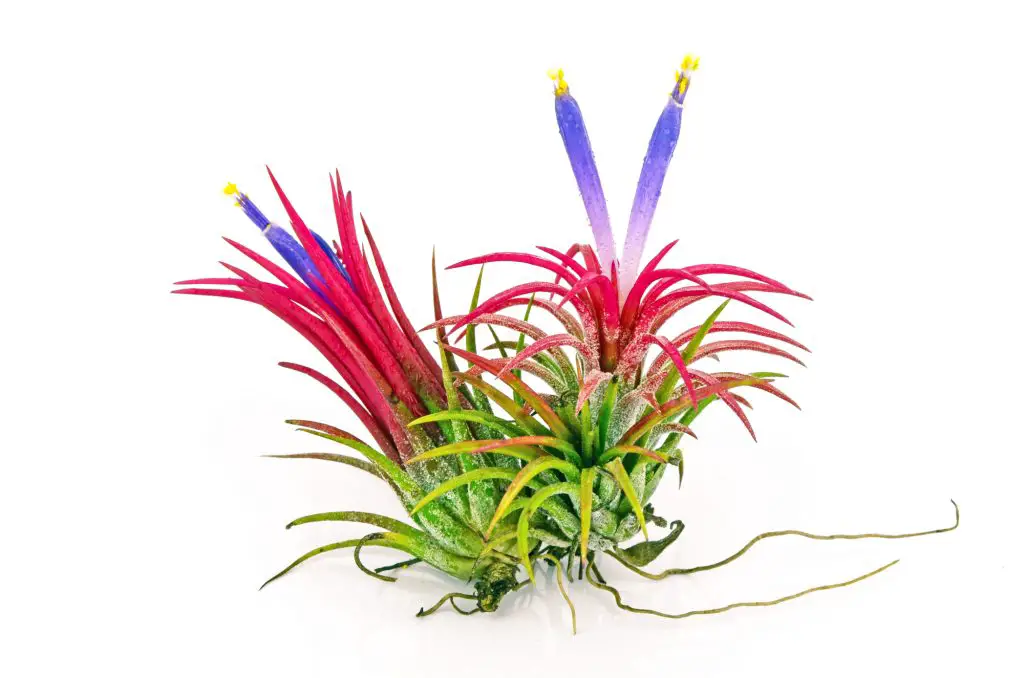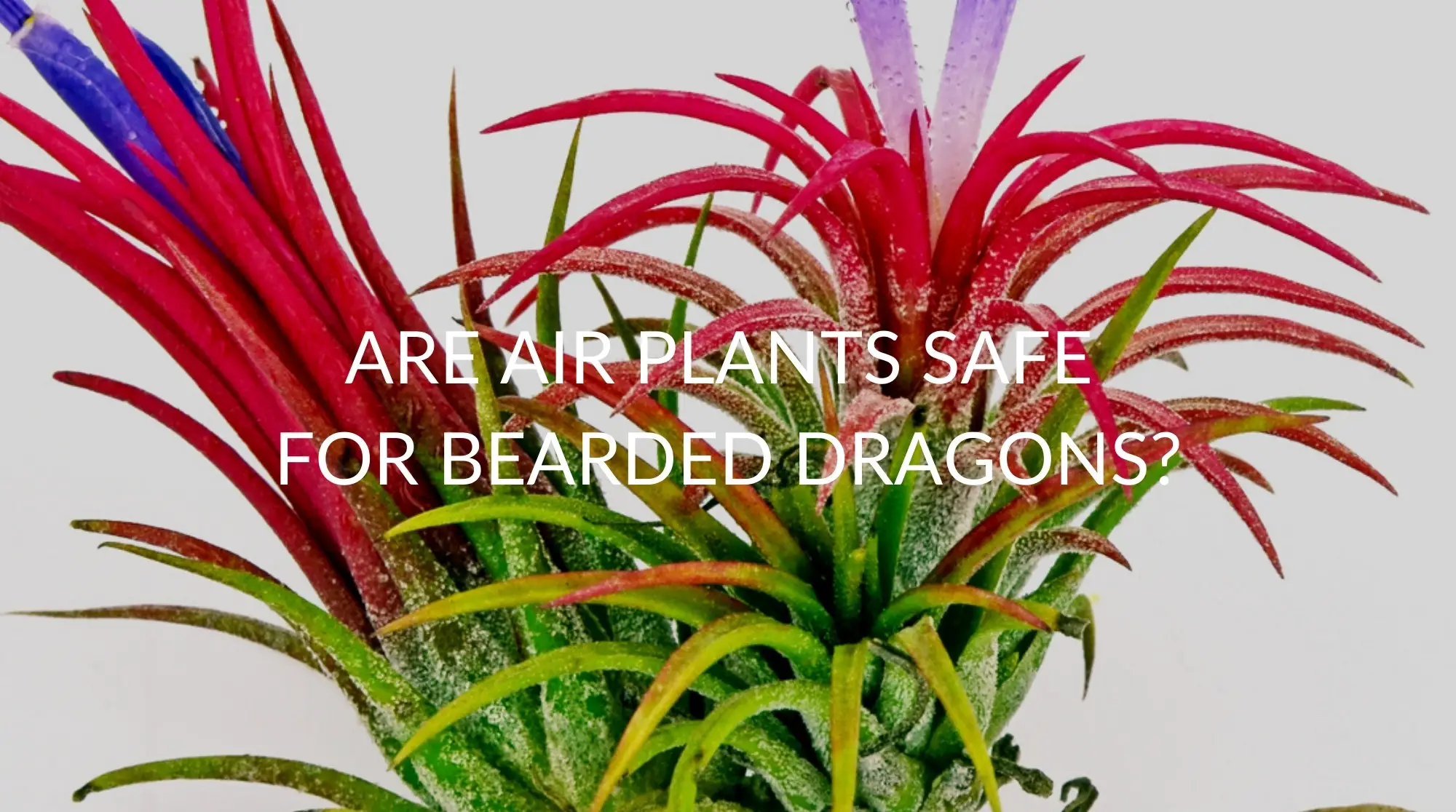Tillandsia, often known as air plants, are an excellent low-maintenance plant to keep in your reptile’s enclosure because they only grow 2 to 4 inches tall. They also require very little water. Simply spray the air plants in your reptile cage with a spray bottle once every two weeks.
Continue reading to find out if air plants are suitable for lizards and other reptiles, as well as which plants are dangerous to reptiles, as well as which plants are safe to use to adorn your reptile enclosure.
Are Air Plants Safe for Reptiles?
Air plants come in over 400 different types, none of which are hazardous to people or animals. So, your cats, dogs, birds, bunnies, and reptiles like geckos and bearded dragons are safe with these plants.
Tillandsias have become a popular house plant used to decorate a reptile tank since they thrive in a dry climate and require minimal water. Some reptiles have even been known to like eating this plant, but the problem is that the more they consume, the less appealing the plant becomes.
Are Air Plants Poisonous to Lizards?
Plants are essential in constructing a prosperous, healthy, and happy bioactive enclosure for your lizard. In nature, lizards filter the air and water, produce oxygen, aerate, improve the soil, and provide food for animals, among other functions. Therefore, you can’t have a fully bioactive environment without live plants.
When you have a pet lizard, you should be cautious about the plants you put in their enclosure. The color green stimulates their appetite, and it’s possible that they’ll take an exploratory nibble or two, if not the entire plant. Fortunately, many plants are safe for reptiles to consume, and air plants are among them.

Are Air Plants Safe for Bearded Dragons?
Air plants are considered a prevalent safe plant kind that’s usually seen in bearded dragon habitats. The Tillandsia Ionantha, for example, is a widespread shrub in desert environments.
This plant, also known as the blushing bride, has pink-red blossoms and even purple blooms, making it a lovely accent. It’s a low-maintenance plant that doesn’t need much water, so a gentle spritz every two weeks should be enough. You may stick this air plant to rocks, the enclosure’s backdrop, or elsewhere.
The plant maintains its modesty so that it does not take over the cage. However, if you want to entirely fill a space, this will not work. Feeding your bearded dragon is also perfectly safe.
What Plants Are Safe to Put in With Bearded Dragons?
Prickly-Pear Cactus
Bearded dragons can comfortably ingest prickly pear cacti, and some keepers even give their lizards prickly pear cactus pads as a nutritious snack.
Owners should, however, note that the Prickly pear cactus spikes may injure or irritate your lizard. However, Cacti with their spines removed are widely available. You may also need to maintain your prickly pear cactus trimmed on a regular basis to prevent it from outgrowing its container and hurting your lizard.
Haworthia Plants
Haworthia plants are popular terrarium plants for people who keep desert-dwelling reptiles. Nevertheless, some Haworthia species, such as Haworthia cooperi or reinwardtii, are thought to be more suitable for a bearded dragon habitat. Despite this, most Haworthia plant species are hardy, easy to care for, and completely safe for bearded dragons.
The modest size of a Haworthia plant is one of the characteristics that makes them ideal for bearded dragon homes. Haworthia plants usually develop as tiny buds of leaves and typically only grow to be a few inches in size.
Aloe Vera Plants
Aloe plants have long been known for their therapeutic properties, and they make excellent bearded dragon habitat additions. While the majority of aloe vera plants have green leaves, others have beautiful, mottled patterns. All of these things are appealing to the bearded dragon. However, owners should be aware that, despite the fact that certain aloe vera plants have extremely prickly leaves, they do not appear to bother pet lizards.
Household Herbs: Basil, Parsley and Oregano
Some popular culinary herbs make fantastic additions to the cage of your bearded dragon. Basil, for example, thrives in a warm atmosphere, making it an excellent choice for terrarium cultivation. Because the leaves may be appealing to your bearded dragon, he may represent the most serious threat to the plant. Your lizard will not be poisoned by basil, but it may consume it quicker than the plant can take.
Another great addition to your bearded dragon’s surroundings is parsley. The primary rationale for including herbs like parsley in your lizard’s habitat is that it is both pleasant and healthy. Since some keepers routinely incorporate herbs such as basil and parsley in their pets’ meals, it may be easier to just grow it in your reptile’s habitat to guarantee that your bearded dragon always has access to fresh, edible food.
Another safe and edible plant that may be used in a bearded dragon cage is oregano. Your bearded dragon, on the other hand, is unlikely to consume it. It is, nevertheless, devoid of thorns and other possible hazards.
Dwarf Jade Plants
Dwarf jade plants are known to be safe for all reptiles, including Bearded dragons. Since people use the leaves of the dwarf jade plant in salads, this leaf may make excellent additional food for your reptile habitat.
Dwarf jade plant cuttings are also often easy to transplant and take root rapidly, making it simple to grow your dwarf jade plant into numerous plants on your own to beautify your tank and provide a friendly diet for your reptile.
What Plants are Poisonous to Bearded Dragons?
Azalea Plants
Azaleas are blooming shrubs that come in a variety of colors and kinds. The entire plant is poisonous and should be avoided at all costs. Both the leaves and nectar of azaleas contain andromedotoxins. Unfortunately, nausea, vomiting, sadness, and trouble breathing are common following exposure to the plant. If you give your bearded dragon too much of the herb, it might put him in a coma.
Elderberry Plants
Elderberry is a well-known herb that is utilized for therapeutic purposes. The leaves and berries can be consumed in tiny amounts and under particular conditions by humans. Elderberry is dangerous under uncontrolled settings and should not be housed or fed to Bearded dragons in any shape or quantity.
Juniper Plants
Bearded dragons are poisoned by both the juniper leaves and the berries produced by the plant. Only the berries of the Common juniper tree are utilized for flavoring purposes in humans. The berries of the other species are either bitter or toxic. As a result, Bearded dragons should not be given juniper leaves or berries from any Juniper tree.
Holiday Favorites Like Mistletoe, Holly or Poinsettia
Plants such as mistletoe, holly, and poinsettias adorn grocery shelves throughout the holiday season. While they are lovely plants, keep them out of your reptile’s terrarium and away from any areas where your pet could investigate.
Holly is a lovely Christmas adornment, but the berries are toxic to alive humans, animals, and reptiles. Vomiting, diarrhea, drooling, lip-smacking, and head shaking are all common symptoms of poisoning due to these holiday favorites. Due to its prickly edges, the plant’s leaves can also be dangerous to tiny reptiles.
Mistletoe is known as the “love plant” and is another popular Christmas decoration. However, to reptiles, the plant is extremely poisonous, causing vomiting, diarrhea, difficulty breathing, shock, and even death. Although modest amounts of the berries or leaves are unlikely to cause significant poisoning, they should nevertheless be kept away from pets.
Finally, because they bloom in December, poinsettias are a popular plant throughout the Christmas season. Their vivid crimson flowers are actually leaves, and when coupled with the green foliage, they make the ideal Christmas decoration. Poinsettias are only minimally poisonous, causing drooling, lip licking, vomiting, diarrhea, skin irritation, and eye discomfort. Ingestion or direct contact with the plant’s milky sap might produce symptoms.
Wondering whether Air plants are dangerous to your cats?
Primrose Plants
The Primrose plant’s leaves are coated with tiny hairs that release poisons. If your reptile even passes by a primrose plant, it is likely to get irritated and develop painful blisters or dermatitis. Ingestion of the plant can also cause moderate vomiting and digestive issues for your bearded dragon.
Recap
There are about 400 distinct varieties of air plants, none of which are harmful to humans or animals. As a result, your reptiles, and lizards, such as geckos and bearded dragons, are safe to live with and eat these plants.
Since they thrive in a dry area and require little water, tillandsias have become a popular house plant for reptile tanks. Prickly Pear Cacti, Haworthia, Aloe Vera, and common household herbs like Parsley, Basil, and Oregano are all safe to keep in a bearded dragon tank.
On the other hand, plants like azalea, elderberry, juniper, primrose, or holiday favorites like holly, mistletoe, or poinsettias should never be placed in a lizard terrarium and should actually be kept out of reach of all household pets.

